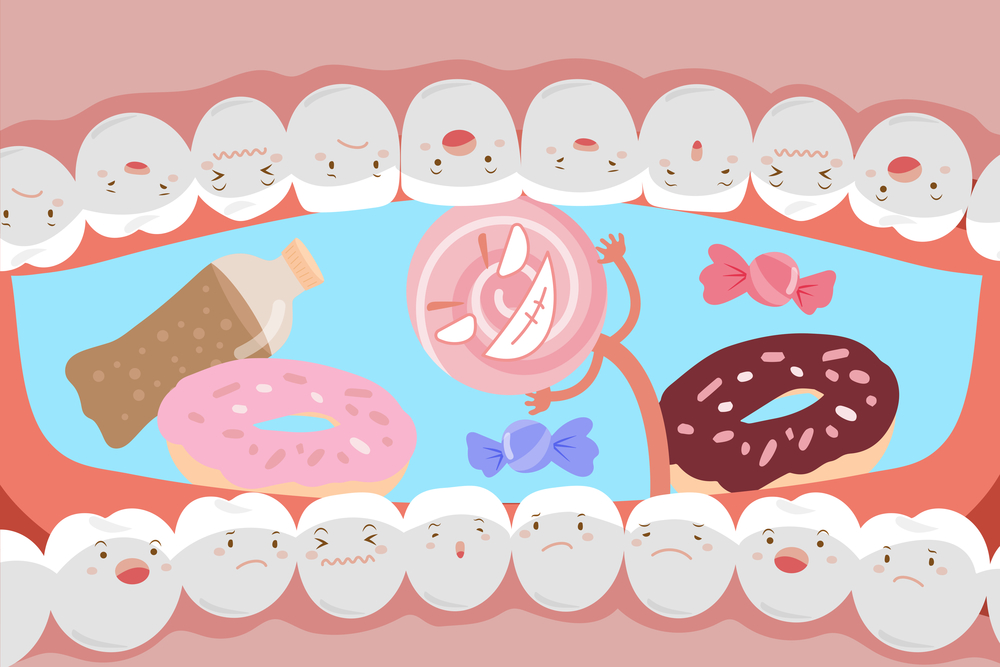With Easter just around the corner, kids around the country will be salivating at the thought of all the chocolate treats to come. Whilst we all enjoy a delicious chocolatey treat or two, it is worth remembering there is a direct link between dental decay and a diet high in sugar.

We have known for a long time that tooth decay is caused by bacteria in our mouths. When we consume sugary foods and drinks, the bacteria will use the sugar to produce acid. It is this acid that dissolves the teeth, causing cavities. The duration of food in the mouth is the most critical factor leading to tooth decay, as the acid produced by bacteria will last approximately 20 minutes before being neutralised by saliva.
Most adults and children consume more sugar than is recommended for a healthy balanced diet. Some research would suggest that our current consumption of “added sugars” is equivalent to 26 teaspoons of sugar a day.
The longer a sugary food is in contact with a tooth, the more damage is likely to be caused. Regular snacking and grazing will increase the risk of tooth decay as the teeth are bathed in acid for longer periods of time.
However, a recent study from Europe has expanded the risks of sugar to include all dental disease including gum disease! The theory goes like this – when mouth bacteria produce the decay causing acid, the acidic environment will alter the numbers and ratio of bacteria present, resulting in inflammation of the gums surrounding the tooth. Left untreated, this inflammation will lead to gum recession, bone loss and may eventually lead to tooth loss through gum disease.
The link between blood sugar levels and periodontal disease is highlighted in patients with Diabetes. Diabetes mellitus is a chronic endocrine disorder affecting carbohydrate, fat and protein metabolism in the body. It is caused by inherited and/or acquired deficiency in production of insulin by the pancreas, or by the reduced effectiveness of the insulin produced. Such a deficiency results in increased concentrations of glucose in the blood, which in turn damage many of the body’s systems, in particular the blood vessels and nerves.
In Australia the prevalence of type 2 Diabetes has doubled over the past 20 years. Research has confirmed that people with Diabetes are more likely to have gingivitis (inflamed gums) and periodontal disease (more destructive gum disease), particularly when Diabetes is poorly controlled.
A relationship between periodontal disease and Diabetes goes both ways. Not only do people with Diabetes have more severe periodontal disease, but periodontal disease may make it more difficult for people who have Diabetes to control the condition.
Patients with severe gum disease also have higher levels of bacteria in their bloodstream, and we know there is a direct link between patients suffering heart attacks and strokes with gum disease. Researchers have found that people with gum disease were almost twice as likely to suffer from coronary artery disease as those without gum disease.
If it has been more than six months since you have seen a dentist, you should contact your dentist to make an appointment for a routine examination. The more often you have your teeth cleaned, the less plaque and calculus there will be to remove. Not only will this make the cleaning process easier and less painful, it will also minimise the risk of dental decay and gum disease. Drinking or rinsing your mouth with water following meals, or sugary snacks, is an effective way to remove food debris and help neutralise acid produced by decay causing bacteria. Daily brushing and flossing remain the best way to reduce the risk of dental decay.

Dr Ian Sweeney is a dental surgeon at
Northside Dental & Implant Centre, Turramurra.











